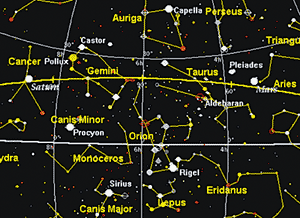Winter nights are glorious! Of the 25 brightest stars, 12 twinkle in the winter skies. Six of these stars form the Winter Hexagon, which dominates the winter sky. (See star chart).
 Our tour of the Winter Hexagon begins with the brilliant blue-white star Rigel, which forms the left leg of Orion 'the Hunter'. At the top of the hexagon is Capella, located in the house-shaped constellation Auriga 'the Charioteer'. Following Orion's belt up and to the right leads us to the next star of the Winter Hexagon, the red-orange Aldebaran, located in Taurus 'the Bull'. Moving straight down and to the left of Capella are two stars of nearly equal brightness that form the heads of the Gemini twins, Castor and Pollux. Pollux is the brighter of the two but Castor is a wonderful triple star system visible through a modest size telescope. Low in the east is Procyon, forming one end of the two-star constellation, Canis Minor. The sixth corner of the Hexagon is the brightest star in the night sky, Sirius. Notice that the three stars in Orion's belt point southeast to Sirius, the Dog Star.
Our tour of the Winter Hexagon begins with the brilliant blue-white star Rigel, which forms the left leg of Orion 'the Hunter'. At the top of the hexagon is Capella, located in the house-shaped constellation Auriga 'the Charioteer'. Following Orion's belt up and to the right leads us to the next star of the Winter Hexagon, the red-orange Aldebaran, located in Taurus 'the Bull'. Moving straight down and to the left of Capella are two stars of nearly equal brightness that form the heads of the Gemini twins, Castor and Pollux. Pollux is the brighter of the two but Castor is a wonderful triple star system visible through a modest size telescope. Low in the east is Procyon, forming one end of the two-star constellation, Canis Minor. The sixth corner of the Hexagon is the brightest star in the night sky, Sirius. Notice that the three stars in Orion's belt point southeast to Sirius, the Dog Star.
Don't forget to observe Venus on Valentine's Day, when it will be at its brightest, giving pre-dawn viewers a sight that's difficult to miss. Venus won't be so striking again until June 2007.
February highlights:
The Sun
The Sun is in the constellation of Capricornus at the start of February, moving into Aquarius on the 16th.
The Moon
The Moon's orbit, experiencing an extreme tilt during 2006, will take it to unusual places: on the 8th, it leaves the zodiac and ventures into the northern constellation Auriga. On the 27th the Moon is closer to the Earth than at any other time of the year, a distance of 347,000km, an extreme perigee.
Mercury
Mercury reaches its greatest elongation east of the Sun on 24 February, so this elusive little planet could be visible in the evening sky. Look for it with binoculars from the 18th to the 22nd, low in the west about an hour after sunset.
Venus
Venus is a brilliant 'morning star', at the first light of dawn low in the eastern sky. On the 3rd, it appears to be motionless in the sky as it moves toward its greatest elongation west of the Sun. On Valentine's Day, look for crescent Venus in the predawn sky through a pair of binoculars.
Mars
This month Mars is at its highest in the early evening and sets after midnight. The 'red planet' is fading as the Earth draws further away from it but can still be distinguished by its reddish-orange colour. Mars is leaving the constellation of Aries and crossing into Taurus on the 8th. Look for it around 17 February close to the Pleiades star-cluster ('Seven Sisters').
Jupiter
Jupiter at mid-month rises by 1AM to appear as a brilliant 'star' with a silver-white lustre in the constellation of Libra, the Scales. It will be primarily a late-night-early morning object from February through April. The giant planet appears brighter than any other star-like object except for brilliant Venus, 60 degrees further left.
Saturn
During February, Saturn rises in the north-east shortly before sunset and will continue to be an evening object through the middle of July. It is moving slowly north-west in Cancer and could be found well below the 'Twin' stars of Gemini.
Meteors
At certain times of the year, the Earth travels through a cloud of interplanetary debris that burns up in its atmosphere and we get a meteor shower in the form of 'shooting-stars'. However, there are no significant showers in February, which is generally also a quiet time for sporadic meteors.


